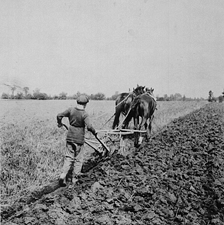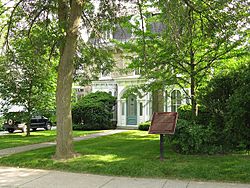Home Children facts for kids

The Home Children program was a plan that sent over 100,000 children from the United Kingdom to countries like Australia, Canada, New Zealand, and South Africa. It started in 1869, thanks to Annie MacPherson. The program mostly stopped in the 1930s but didn't fully end until the 1970s.
Years later, starting in the 1980s, people began to learn about the difficult lives these children had. In 2009, Australia said sorry for its part in the program. In 2010, Gordon Brown, who was the UK Prime Minister at the time, also said sorry to the families of the children who suffered. However, the Canadian Immigration Minister, Jason Kenney, said in 2009 that Canada would not apologize. Instead, Canada chose to remember this "sad period" in other ways.
Contents
A Look Back: How the Home Children Program Started
Early Days: Children as Workers
Sending poor or orphaned children to British colonies to help with work shortages began a long time ago. In 1618, for example, 100 English children were sent to the Virginia Colony. In the 1700s, many children, especially from Scotland, were forced to move to the Americas to work. This practice continued until 1757, when it was stopped after a legal case against some merchants and leaders in Aberdeen.
Helping Children: Good Intentions, Hard Realities
In 1830, a group called the Children's Friend Society was started in London. Their goal was to help young homeless children by sending them to other countries. The first group of children was sent to South Africa and Australia in 1832. In 1833, 230 children were sent to Toronto and New Brunswick in Canada.
Some of the most important people who helped with child migration in the 1800s were Annie MacPherson, her sister Louisa Birt, and Maria Rye. Annie MacPherson was a Scottish Christian who worked with poor children in London. She was shocked by how children were forced to work in the matchbox industry. She decided to dedicate her life to helping them.
In 1868, MacPherson opened the Home of Industry in London. It was a place where poor children could work, eat, and get an education. She soon believed that sending these children to countries with more opportunities was the best solution. In 1870, she began sending children to Canada. She traveled with 100 boys herself. In the first year, 500 children from her homes were sent to Canada. She also helped other groups, like Barnardo's, send children. MacPherson opened more homes in Canada to receive the children. Overall, her work helped find homes and jobs for about 14,000 British children in need.
Maria Rye also worked with poor people in London. She arrived in Canada with 68 children in 1869, even before MacPherson. By the early 1900s, Rye had helped about 5,000 children, mostly girls, settle in Ontario.
In 1909, Kingsley Fairbridge started a society to send children to colonies. His goal was to teach orphaned and neglected children farming skills at special schools across the British Empire. Fairbridge moved to Australia in 1912, where his ideas gained support.
It's thought that about 150,000 children were sent away over 350 years. The first recorded child migrants left Britain in 1618, and the program didn't fully end until the late 1960s. Many people at the time believed these children were all orphans. However, we now know that most of them had living parents. Some parents didn't know what happened to their children after they were placed in care homes. Others were told their children had been adopted somewhere in Britain.
Child migration mostly stopped during the Great Depression in the 1930s because of money problems. But it wasn't completely ended until the 1970s.
Many children were tricked into believing their parents were dead and that a better life awaited them. Some were forced to work hard on farms for very little pay. They were sometimes denied proper homes and education. It was common for Home Children to run away. Sometimes, they found a caring family or better working conditions.
Looking Into the Program: What Was Found
The child migration programs had their critics. There were many rumors that children were treated badly by their employers. There were also rumors that the people running the programs, especially Maria Rye, were making money from it.
In 1874, a representative named Andrew Doyle was sent to Canada to visit the homes and check on the children. Doyle's report praised the people running the homes, saying they had good intentions. However, he criticized almost everything else about the program. He said that mixing children from workhouses (who he thought were mostly good) with street children (who he thought were mostly thieves) caused problems in Canada. He also criticized the lack of follow-up checks on the children after they were placed with families. He stated that:
Because of Miss Rye's carelessness and Miss MacPherson's limited resources, thousands of British children, already in painful circumstances, were cast adrift to be overworked or mistreated by the settlers of early Canada who were generally honest but often hard taskmasters.
After this, the House of Commons of Canada looked into Doyle's findings. His report caused a lot of discussion in Britain. Despite the controversy, the programs continued with some changes and were copied in other parts of the British Empire.
More recently, from 2014 to 2015, the Northern Ireland Historical Institutional Abuse Inquiry looked at cases of children who were forcibly sent to Australia. They found that about 130 young children from care homes were sent to Australia between 1922 and 1995, mostly after World War II.
Discovering the Truth and Saying Sorry
In 1987, a British social worker named Margaret Humphreys investigated the child migration program. Her work led to the truth about the program coming out. She also helped set up the Child Migrants Trust, which aims to help parents and children find each other again. The full details of the program only became widely known in 1998 during a government inquiry in Britain. This inquiry found that many migrant children were abused in religious schools in Australia, New Zealand, and other countries.
In 1994, Humphreys wrote a book about her research called Empty Cradles. In 2010, a movie called Oranges and Sunshine was made based on her book. It showed Humphreys' work, the challenges she faced, and the abuse thousands of children suffered.
Australia's Apology
In Australia, about 7,000 children came through assisted child migration programs. These children are part of a larger group known as the Forgotten Australians. This term describes an estimated 500,000 children who grew up in orphanages, children's homes, or foster care in Australia until the early 1990s.
After groups like the Care Leavers Australia Network pushed for it, the Australian Senate published reports in 2001 and 2004. Both reports recommended a national apology. So, on November 16, 2009, Kevin Rudd, the Prime Minister of Australia at the time, made an apology. The Australian government had asked about 400 British Child Migrants for their advice on how to deliver the apology. Australia's Roman Catholic Church had already apologized in 2001 to British and Maltese child migrants who suffered abuse in religious institutions. The British government also set up a travel fund to help former child migrants visit their families in the UK. The Australian government later added to this fund.
Canada's Recognition
In 1999, the Canadian federal government officially recognized the "Immigration of Home Children" as a National Historic Event. A plaque remembering this event stands in Stratford, Ontario. The Ontario Heritage Trust also put up a historical plaque in Ottawa the year before.
After Australia's Prime Minister apologized, Canada's Minister of Immigration, Refugees and Citizenship, Jason Kenney, said in 2009 that the Canadian government did not need to apologize. He stated:
The issue has not been on the radar screen here, unlike Australia, where there's been a long-standing interest. The reality is that, here in Canada, we are taking measures to recognise that sad period, but there is, I think, limited public interest in official government apologies for everything that's ever been unfortunate or [a] tragic event in our history.
In 2010, the Governor General of Canada declared it the "Year of the British Home Child." On September 1, 2010, Canada Post released a special stamp to honor those who were sent to Canada. In Ontario, a law passed in 2011 made September 28 each year "British Home Child Day." This day is meant to "recognize and honour the contributions of the British Home Children who established roots in Ontario."
United Kingdom's Apology
On February 23, 2010, Prime Minister Gordon Brown read an apology for the "shameful" child resettlement program. He also announced a £6 million fund to help the families affected by the "misguided" program.
Today
In 2011, Home Children Canada stated that about one in ten Canadians is a descendant of a home child. The British government's Family Restoration Fund has helped over a thousand child emigrants travel to reunite with their families. This fund is managed by the Child Migrants Trust.
Media
- Heaven on Earth, 1987 television film
- The Leaving of Liverpool: 1992 television mini-series
- Oranges and Sunshine: 2010 drama film
- Singer/songwriter released the song "Suitcase Full of Lies" in 2021 to go with the History Detective Podcast Season 2 Episode 6: Child Migrants to Australia After WWII.
- Season 4, Episode 1 of the British television series Call the Midwife shows a family of neglected children sent to Australia under the Child Migrant Programme.
- Season 12, Episode 11 of the Canadian television series Murdoch Mysteries, called 'Annabella Cinderella', is about a home child.
See also
- Abuse
- Big Brother Movement
- Child abuse
- Children's Friend Society
- George Crennan, Director of the Federal Catholic Immigration Office in Australia from 1949 until 1995
- Orphan train
- Oranges and Sunshine
- Stolen Generations
- The Children of Creuse, a similar case involving the French departments of La Réunion and Creuse
- Margaret Humphreys


